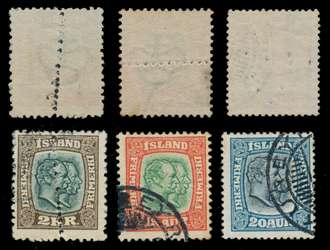|
 |
|
|
Sewing Machine and Needle-Hole Canceled Stamps.
The holes are often not visible from the front.
|
|
|
|
| Iceland: Sewing Machine Canceled Stamps (Revenue Use) |
|
by Jay Smith
This article provides background information about Icelandic stamps with needle or sewing machine cancellations. Such stamps were canceled in revenue use. Details on this subject have been drawn from Gjalda- Og S÷fnunarmerki Auk Stimpla ┴ ═slandi by Ůor Ůorsteins, published in 2000.
Icelandic Sewing Machine Canceled Stamps are offered for sale on the Icelandic Sewing Machine Canceled Stamp web page.
Precursors of the "Tollur" canceled postage stamps, these regular postage stamps were "canceled" with a needle. The cancels exist with holes in a line, from a sewing machine, or with irregularly positioned holes done with a hand-punched needle. They always also bear a postal cancellation.
Stamps were used to pay import duties and taxes starting in 1912 (and export duty starting 1918), however such stamps only bear postal cancellations and are normally indistinguishable from normal postally used stamps.
Starting with a law passed 15 April 1920 the stamps paying the duty/tax were to be (additionally) punched by auditors in Reykjavik and then the waybills bearing the stamps were returned to the post office from which they had been sent for audit. Initially the punching was done with needles or hole-punches, but on 29 June 1920 the post office in Reykjavik bought a sewing machine for the purpose. (Thus stamps canceled before that date should show random hole patterns and cancels soon after that date will likely show lines of holes from a sewing machine.) A non-postal government-paid worker was hired to operate the machine (thus there must have been considerable volume).
Effective 1 January 1922, the stamps paying the duty/tax were to be affixed directly to the parcel (instead of a waybill) and (only) postally canceled, ending the era of hole-punching. Thus the era of hole-punched stamps is 15 April 1920 through 31 December 1921.
Stamps canceled in this manner are very scarce -- many collectors discarded them years ago, regarding them as damaged stamps. Their real status was not known outside of Iceland until recently and their status is still little-known, even in Iceland. As with Tollur-canceled stamps, most lower denominations with punched cancellations are much scarcer than the higher denominations.
All of the examples I have seen with identifiable postal cancellations have had AKUREYRI (vast majority) or REYKJAVIK cancels. However, most of the examples that I have seen have come from a single old-time estate. It is just chance that the examples I have seen come primarily one source and thus it may be just chance that those stamps mostly have the same town postmark. However, cancellations are likely to be mostly from the larger, coastal towns with significant import/export traffic. Cancellations are likely to be rare (if they exist at all) from small, internal towns & villages located away from the coast.
Examples with clear month & year dating are extremely unusual and command significant premiums; even examples with clear year dating are very scarce.
Note: It would not be difficult to fake such stamps. Thus buyers should be cautious about examples sold at a high premium that come from unverifiable sources and/or without provenance. Though they are much scarcer, it is preferable to find examples showing cancellations dated in the period of use (vs without showing a date). However, remember that any examples canceled outside the period of use are probably just damaged stamps. The normally less costly stamps are more costly hole-canceled whereas the normally costly stamps are usually less costly hole-canceled.
Remaining research opportunities: The known stamps should be recorded. The known town postmarks should be recorded, for each different stamp, along with postmark dates. I have yet to see any examples still on waybills; if they exist, they should be documented.
Notes on the examples I have recorded: (as of December 1, 2012)
Scott #77, 15 aur Two Kings. This stamp is usually poorly centered. All that I have seen have a straight line of holes. All I have seen either have AKUREYRI cancels or are unclear, but look like they are from the same source.
Scott #82, 50 aur Two Kings. This stamp is usually poorly centered. I have only had TWO examples, both similar, both with irregular holes (not made with the machine), but acquired from different sources.
Scott #84, 2 kr Two Kings. I have seen more of the 2 kr than any other value. Most have had very poor centering (as if the post office was trying to use up substandard stamps). Most examples I have seen do not have readable cancels, but most that were readable have been AKUREYRI, with just a very few REYKJAVIK. The examples I have seen have been a mix of random holes and straight lines of holes.
Scott #85, 5 kr Two Kings. Note this use is much more rare than normal postal use, but costs much less than normal postal use. I have only had TWO examples, of similar appearance, but acquired from different sources.
Icelandic Sewing Machine Canceled Stamps are offered for sale on the Icelandic Sewing Machine Canceled Stamp web page.
|

